Article and photos by Joe Mish
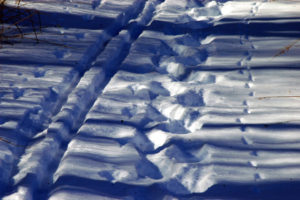
The hiker skier and the fox
passed this way on a snowy walk
The same path was taken on that day
Though each saw things a different way
Dawn was hardly accomplished when the charcoal sky, stirred by a strong cold wind, began to hurl sharp ice crystals against the dry fallen leaves. The High velocity ice pellets struck the forest floor to reverberate against the dry leaves and create a mesmerizing steady hum.
The expansive old woods, now under siege by the late November weather, had a logging road cut through it sometime in the past that now resembled a linear scar threading through the trees. The thick canopy of branches blocked the sunlight to prevent the cut from healing and provided an unobstructed view and silent pathway, for at least a hundred yards. Any bird or animal travelling across the woodlot could be easily seen.
From my vantage point, where the road curved around a large boulder to the straightaway before me, I paused to take in the view. The falling ice began to accumulate; it was like watching an invisible hand weave a white rug on a rough umber tinted latticework. The ice would take turns with large snowflakes as this tandem team laid down white pavement on the road. The thick canopy of branches in the surrounding woods prevented much of the falling snow from reaching the ground. The white flakes and ice crystals that fell here resembled a light scattering of powdered sugar that stood in stark contrast to the near solid white woods road.
The woods are transformed with a light snow as hidden pathways and game trails show up as white lines and the thick woods instantly fitted with clear windows into the woodland depths. Any animal previously hidden by the labyrinth of branches in the one dimensional muted background of similar color, now are exposed as dark forms against white as they pass through these previously invisible portals. The slightest movement, even at a distance, now betrays an animal’s presence as sound becomes an irrelevant turncoat.
Feeling chilled, I was about to resume my walk when a quick movement in the woods caught my eye. Like watching a silent movie in black and white, a woodland drama was about to unfold.
Some small, fast animal was running along the ground in a straight line, on a course that would take it across the woody lane. In short order it appeared in the open and I was still questioning its identity. I could now see this was clearly a bird as it looked like a pigeon, though slightly larger. It was so odd to see a bird running instead of flying and given its speed, its health did not seem compromised. The fleet footed bird was a ruffed grouse! I recalled seeing grouse feeding in the predawn light on other occasions and thinking how they resembled pigeons.
In less than 15 seconds, another larger form appeared and was clearly running along the same track as the grouse. This was a red fox!
The fox had probably gotten a glimpse of the grouse, lost sight of the bird, then picked up its scent to begin the chase. The grouse felt confident enough it could escape on the ground as the fox was in steady but lagging pursuit.
The bird would take to the air if the fox came within striking distance and barring intervention from a hungry cooper’s hawk, the grouse would enjoy the rest of the day in peace. The fox was on a foolish pursuit chasing an alert grouse. Its hunger in full argument with its experience arrived at a compromise and the chase began in deference to hunger.
I waited another few minutes and couldn’t resist trying to call the fox in. Like magic the fox came running, sat at the edge of the lane in the white snow and stared in my direction for a good minute, stood up and trotted off.
As the fox disappeared in the distant woods I again began to walk down the canopied lane enjoying the snowy woods.
The old logging road weaving through the trees scattered with snow brought the lines from poet Robert Frost to life. From “A road not taken”:
“… and looked down one (road) as far as I could, to where it bent into the overgrowth”.
Then the line from Stopping by the woods on a snowy evening:
“…to watch his woods fill with snow”……
“The only other sound’s the sweep
Of easy wind and downy flake.”
Unwrap the gift of a light November snow and enjoy sights and sounds that have inspired the verse of American Poets.
Author Joe Mish has been running wild in New Jersey since childhood when he found ways to escape his mother’s watchful eyes. He continues to trek the swamps, rivers and thickets seeking to share, with the residents and visitors, all of the state’s natural beauty hidden within full view. To read more of his writing and view more of his gorgeous photographs visit Winter Bear Rising, his wordpress blog. Joe’s series “Nature on the Raritan, Hidden in Plain View” runs monthly as part of the LRWP “Voices of the Watershed” series. Writing and photos used with permission from the author.
Article and photos by Joe Mish
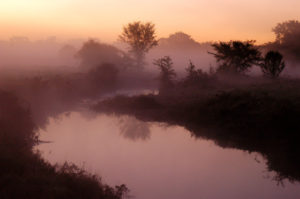
The dawn of the first day of September turns a mundane view of Holland Brook into a scene of stunning beauty that vanishes in the light of day
September arrives with the gentleness of the March lamb, whose fleece is tinged with shades of orange, scarlet and yellow. This month is shepherded in by a genial sprite whose name is associated with autumn, even though 21 days out of 30, are owned by summer.
The dominant green of summer foliage and grass is now the canvas upon which colors begin to appear. The classic autumnal portraiture is prompted by the choreographed movement of the planets which direct changes of light and temperature on earth.
September imperceptibly, at first, applies a touch of persimmon to leaves of the black gum tree, found in moist upland areas of the upper Raritan watershed. That shade of orange stands out boldly against the mass of green. Its elongated leaf, larger at the base, tapering to a rounded tip, suggests a festive light, reminiscent of an old fashioned Christmas tree light bulb.
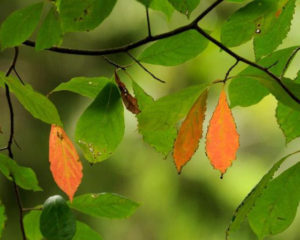
Perhaps using a fine squirrel tail paint brush, and confident from the first strokes of subdued orange, deep scarlet begins to appear on trees as the subtle necklaces of green Virginia creeper vines now glow a brilliant red. The necklace is the first adornment applied, before dressing in the full compliment of matching fall color later in October.
Happy with its brush stokes and color selection, September lingers in the red spectrum to color poison ivy at the base of trees to appear as a ground hugging extension of the soon to be, colorful tree tops. The poison ivy is also used to decorate unsightly stumps and dead limbs close to the ground to clean up the scene with a colorful red and orange cover cloth.
Imbued with the freedom of a bohemian artist, buoyed by success, the compound leaves and fruit of the staghorn sumac, is chosen as a progressively bold, next move. The deepest reds are mixed to produce a flat, dark maroon to saturate the trees large, upright velvety seed cones. Another blend of scarlet and bright red is mixed and applied to the long compound leafs which so easily wave in the slightest summer breeze and glow in the low sunlight when covered with early morning dew.
Taking a step back to view the perspective of its green canvas scattered with specks of color, September wants to jump ahead and fulfill October’s contract and apply full color to the landscape.
The planets and stars, however, have strict rules by which months must abide. Not to be discouraged, September discovered a way to express its soul in full color and still be true to the rules of nature.
While temperature, atmosphere and light invisibly impact the color of leaves, their physical nature allows these invisible conductors to be seen in full color in certain conditions. September would paint the atmosphere using temperature and light as its medium to transfer momentary color, making the entire landscape come alive!
The daily temperature difference that occurs during the summer to autumn seasonal transition produces heavy morning mists along waterways that is showcased in the arena of open meadows and flood plains.
Dawn along the South Branch in September can be very dramatic as the low morning sun shining thru clouds and dust particles produces constantly changing, breathtaking colors in the sky, water and lingering mists. The lighting and colors are so dramatic; the same scene is not recognizable in full daylight.
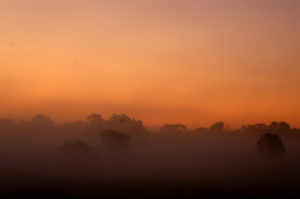
The ability to dabble in orange and red poison ivy and then produce an ever changing orange sky set upon a purple haze is nothing short of pure magic. Actually, it is all science, for the moment, however, magic best describes a September morning.
September was restrained from applying more color to static objects during its tenure but found a way to make God movie background scenes using the most brilliant colors of visible light, atmosphere and temperature.
Author Joe Mish has been running wild in New Jersey since childhood when he found ways to escape his mother’s watchful eyes. He continues to trek the swamps, rivers and thickets seeking to share, with the residents and visitors, all of the state’s natural beauty hidden within full view. To read more of his writing and view more of his gorgeous photographs visit Winter Bear Rising, his wordpress blog. Joe’s series “Nature on the Raritan, Hidden in Plain View” runs monthly as part of the LRWP “Voices of the Watershed” series. Writing and photos used with permission from the author.
Article and photos by Joe Mish
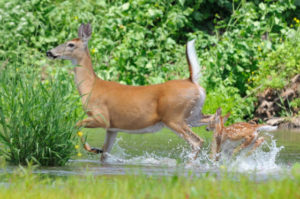
Doe and fawn kick up thie heels in the cool water of the South Branch of the Raritan.
Deer love to wade in the river, even at noon, on the hottest summer days
High Summer Drama
The low dam at Red Rock Lake turned the water of the South Branch inside out to create an unbroken white line along its length. Here, the living water falls upon itself in an act of resuscitation, no different from lifesaving CPR.
Below the dam, the freshly oxygenated water rushes to fill a deep cut in the river bed funneling its energy, impeded elsewhere by shallows and exposed tree roots.
At the start of each trip, below the lake, I do an upstream ferry across the fast water as a tribute to the river’s energy. I provide the proper angle and the river obliges with a free ride across the current with no downstream slip. Angle the bow into the opposing current and the boat spins into a downstream posture to start another river journey through the high summer season.
The water’s surface reflected the bright blue summer sky and lush greenery along the shoreline. The river banks falsely declaring a limit to the infinite reach of the sky.
August is indeed high summer, all plant life at full maturity vying for sunlight, slender and long, eager to dance in the gentle summer breeze.
Lush, light green grass hung over the river bank in one treeless stretch when I saw a painted water snake swimming to the opposite shore. Only the head of the snake, which created a small wake, betrayed its presence. As I neared, the snake slightly altered course. A few feet from the left shore it suddenly rose up, as if struggling. It would have had to press up against something to rise as high as it did and since the water was still quite deep, it begged investigation.
In an instant a snapping turtle’s head broke the surface of the water, draped in dark green grass and holding the snake near the end of its tail end. Such a non vital hold promised a long struggle and struggle the snake did. I began to record images of this fight for life, so inconsistent in such a peaceful setting.
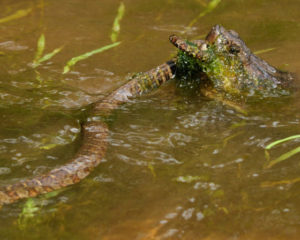
The surprise reptilian clash held the colorful snake in close contrast to the turtle’s head. The turtle’s mouth was more of a razor edged compact beak, a creamy tan with fine vertical black lines. The round orb of its bulging eye and dark pupil were the only recognizable shapes against a pattern of dull and dark brown irregular patches that covered the turtle’s head. The black pupil was surrounded by three thick, dark brown streaks radiating out at 3, 6 and 9 o’clock positions, a pattern quite like a style of crosshair seen in some rifle scopes.
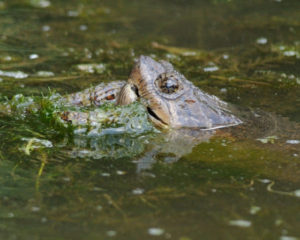
The painted water snake, alias, northern water snake, by its nature, was a linear billboard showcasing a recurring pattern of a variety of shades of tan and orange, and black, the pattern getting tighter and more compact near the tail. The snake must a have just shed, as its colors gleamed to a high shine, enhanced by the water.
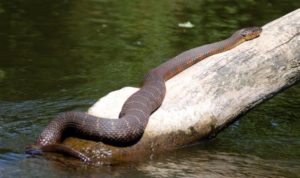
This is a painted/northern watersnake; the colors are more brilliant just after it sheds its skin.
This snake recently dined on some other good sized aquatic critter, now seen as the large bulge in the snake’s stomach.
The fight raged on for several minutes, coming to an abrupt end when my boat drifted closer to the combatants. The turtle became intimidated and released the snake, drama over, no evidence of what had just taken place except for some digital images. I imagine the education of both animals was advanced by their encounter.
A mile down river the scenery changed as the main current, hugging the up heaved, high, red shale cliff, was slowed by a gravelly shoal stretching across the river. Here, the high cliff disappeared back into the ground to give way to a woodsy landscape. The river narrowed and water became deeper. The tree tops reached across the river to give the impression of a leafy tunnel. This was a straight, short stretch that now opened up to allow the first river view of the Sourland Mountains. An island divided the river here, diverting more water to the right passage around a sharp bend, than to the left.
The island had a few small trees smothered in tall sun drenched, light colored grass that reached into the shallow water. Recent events had kept the water level far below normal and as a result, the delicate grass began to grow and prosper where it normally would not. The water level on this day was now raised and flooded the fine green grass.
Here, the river bed follows a deep, narrow cut, close to the right shore and obstructed with fallen trees. From the island to the cut, the river was impassably shallow. Coming around sharp bends on an intimate river usually holds the best surprises. Today was not a disappointment as a doe was standing in the water staring at me from 20 feet away.
There was little I could do keep still, as the narrow passage along the bank required some quick paddle strokes to avoid being grounded. That mandatory movement caused the doe to run off, seeming more annoyed than frightened. Behind her were two spotted fawns that splashed away through the shallow water and tender grass. The one fawn ran toward a second doe, keeping close to her heels. Alerted, the doe and fawn ran a few paces and stopped. They really were reluctant to end their mid day romp in the cool river. Water droplets flew in slow motion as the doe and fawn ran off two more times. The light green grass was finely detailed, while the same green scene reflected in the water, lost the detail, but kept the essence of the verdant color to make the foreground and background indistinguishable from each other. The two deer, resplendent in their red summer coats, the fawn, speckled white, complimented the green background.
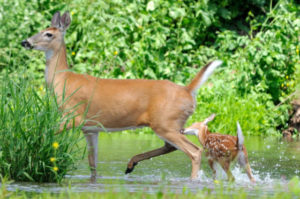
The water exploded from splashing hooves to energize the scene, as it stood in contrast to the reflective water. Raising her pure white tail, the doe provide an exclamation mark to the perfect image to represent high summer on the South Branch.
Author Joe Mish has been running wild in New Jersey since childhood when he found ways to escape his mother’s watchful eyes. He continues to trek the swamps, rivers and thickets seeking to share, with the residents and visitors, all of the state’s natural beauty hidden within full view. To read more of his writing and view more of his gorgeous photographs visit Winter Bear Rising, his wordpress blog. Joe’s series “Nature on the Raritan, Hidden in Plain View” runs monthly as part of the LRWP “Voices of the Watershed” series. Writing and photos used with permission from the author.
by Joseph Sapia
Gardening: In Helmetta, Monroe, and Jamesburg
2016, August 7, Sunday, to August 13, Saturday
The gardening and yard references are to my house in the section of Monroe between Helmetta and Jamesburg in South Middlesex County. My yard is in a Pine Barrens outlier on the Inner Coastal Plain, the soil is loamy, and my neighborhood is on the boundary of Gardening Zones 6b and 7a.
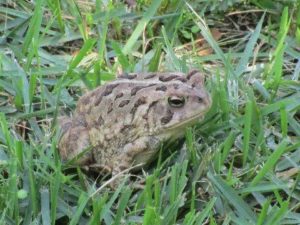
Fowler’s Toad
HARVESTING: Cucumbers. Picked a cantaloupe, but I should have waited. So, holding off on picking more cantaloupes.
TO HARVEST OR NOT TO HARVEST: My tomatoes are not moving – they are not growing and ripening, plants are dying. I think the wildlife has been getting to them….
THE LAWN: Because of work and the weather not cooperating on my days off (that is, either raining or threatening thunder storms with lightning), I got way behind on cutting the grass. So,…
CUTTING THE GRASS IN THE HEAT: I jumped on a sunny, day-off opportunity to cut the lawn – in 95 degrees with a heat index of 114 degrees. I wet my straw hat, stayed hydrated by drinking plenty of water, and took breaks. It was a grind for this old (59) boy. Three wet T-shirts and one fear-of-lightning break later, I finished the backyard.
CUTTING DOWN THE GARDEN: I mowed over the area where the lettuce had been planted – and, now, considering planting a late crop of lettuce. I also mowed down for the most part the done-producing corn stalks.
WILDLIFE IN THE YARD: The raccoons continue to topple the bird-feeder if I do not get it in the garage early enough at night. And I came across a Fowler’s toad — easily identifiable by the several warts in the splotches –while cutting the lawn. And, yes, the toad urinated when I caught him. I let him go in one of the high-grass wildlife patches I keep in the yard. (Photo of the Fowler’s toad.)
ROSE THORN IN MY FOOT: Despite wearing sneakers, I got a rose thorn in the big-toe area of my right foot. Pulled that sucker out fully. Not like the thorn or whatever that I have/had stuck in the ball of my left foot for about three weeks. Just keeping an eye on it, making sure it is not infected, waiting for it to work itself out.
MOSQUITOES: NJ has had at least three cases of West Nile virus in humans – one in Camden County, according to the state; two in Monmouth County (Atlantic Highlands and the Spring Lake area), according to the county. I checked a barrel I keep with a combination of rain, gray water, and de-humidifier water and found mosquito larvae in it. So, I emptied some of it and put a top on the barrel of the remainder. Interestingly, I cannot recall one mosquito bite this season.
— Joseph Sapia
2016, August 13, Saturday,
Joe Sapia, 59, has lived his whole life in Monroe. He is, among other things, a Pine Barrens naturalist and a vegetable gardener. He gardens the same backyard plot as did his Italian-American father, Joe Sr., and his Polish maternal grandmother, Annie Poznanski Onda. Both are inspirations for his vegetable gardening. And he draws inspiration on the local Pine Barrens from his mother, Sophie Onda Sapia, who lived her whole life in the local Pines, and his grandmother.
Call for Proposals
coLAB Arts and the Lower Raritan Watershed Partnership are seeking submissions for proposals for new works of found object sculpture using items of trash collected from the Lower Raritan Watershed (The Raritan River and its tributaries).
What is the Watershed Sculpture Project?
This project is the result of a partnership between coLAB Arts and the Lower Raritan Watershed Partnership (LRWP). Our organizations seek to create awareness of the maturing visual arts scene in the Lower Raritan Watershed as well as the need for community involvement to restore local environmental health. coLAB Arts and LRWP coordinate volunteer clean-ups of area streams and from the refuse collected we identify objects to give to commissioned artists who then create original sculptures for public display.
2016 Commission Theme
In 2016 The Watershed Sculpture Project will work with the theme of “Frames.” We ask that all proposals incorporate this idea literally in the creation of a sculpture that frames the landscape and can be installed semi permanently along the Raritan River Waterfront at Boyd Park in New Brunswick. Additionally, we hope the work “frames” a conversation on how viewers can interact in more positive ways with New Jersey’s largest major waterway.
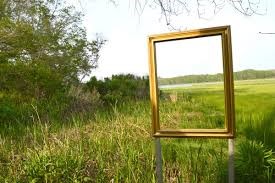
Sample image of framing landscape concept
2016 Commission Fee
$150
Materials
Examples of previous year’s materials may be found here: http://www.colab-arts.org/watershedsculptureproject/ Materials sourced have included, plastic bottles, shopping carts, wood, children’s toys, broken ceramics and glass, etc. coLAB Arts and LRWP have stockpiled a small collection of usable materials from previous clean-ups but will also organize a 2016 clean-up toward the end of August 2016 based on interest from selected artists. Because of project goals we ask that artists be cognizant of making their projects entirely or almost entirely of collected clean-up items. In addition, we ask artists to consider not using toxic adhesives or paints.
Display Requirements
September 25 – Raritan River Festival, Boyd Park
October 1 – “Watershed Moment” event Boyd Park
Winter – Fall 2017 Watershed Gallery, Wellness Plaza, New Brunswick
All sculptures will be displayed for two major events one week apart in Boyd Park in New Brunswick. Final sculptures should be constructed to survive in the park semi-permanently during the fall months. All work will then also have a year-long display at our permanent lobby-style gallery space in the Wellness Center Plaza in New Brunswick.
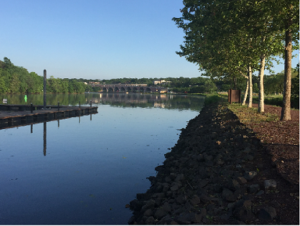
Boyd Park Waterfront in New Brunswick, NJ
Contact
Please submit a simple proposal idea by August 15 2016 to:
John Keller
Director of Education and Outreach
Curator, Watershed Sculpture Project
jpkeller@colab-arts.org
(732) 718 – 7614
In May, Alison M. Jones, Executive Director of our international partner organization No Water No Life, gave a talk in Tewksbury Twp. on the upstream-downstream issues of the Raritan Basin. Alison writes: “The audience was surprised – and then concerned – about the issues faced in the Lower Raritan and that some of the problems flowed down from the Upper Raritan.” After hearing Alison speak, one member of the audience was inspired to write an article for The Bernardsville News comparing the upstream-downstream disconnect in the Raritan Basin to the problems that led to Flint, Michigan’s drinking water debacle.
As in Michigan, in New Jersey we also face a state government willing to accept the public health risks of ignoring – and even compromising – necessary drinking water protections. The Christie administration has put new regulations into effect that will loosen the state’s clean water rules, opening up close to 400,000 acres of sensitive lands to development. While maintaining the integrity of upstream lands is clearly important for communities at higher elevations, the new regulations will have especially dire public health impacts on the state’s historically impaired and poorer downstream areas including the Lower Raritan and Raritan Bay. By opening up upstream lands to development, our downstream areas face compromised drinking water supplies, intensification of flooding, and increased water contamination associated with stormwater flows.
Senator Bob Smith, sponsor of Bill SCR66 that would invalidate Christie’s revisions to the Flood Hazard Control Act rules, has successfully pushed his bill through the Assembly and Senate Committees. There is significant support in the Senate for the bill, including from former Governor Tom Kean, the final hurdle is for Senate President Stephen Sweeney to post the bill to a vote in the full Senate today.
It is not news to our Lower Raritan communities that water, and all attendant pollution, runs downhill. The daily work in our downstream areas must address the clean-up of not only legacy industrial contamination but also non-point-source pollutants that are carried from upstream. The LRWP has been part of a statewide campaign to support Smith’s bill and to encourage Sweeney to post this bill for a vote in Senate, but successfully addressing historic and ongoing threats to the health of our downstream areas will require new and ongoing forms of regional cooperation. Clean drinking water and the health of our communities is at stake.
Article and photos by Joe Mish

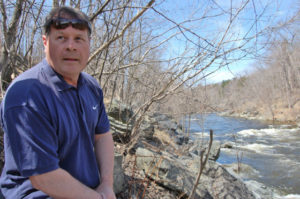
If shadows and footprints were indelible and double exposures across time possible, you might be able to see Henry David Thoreau standing next to Joe on the shore of the Raritan River in New Jersey and the rocky streamside of the Kenduskeag in Maine. Each contemplating the wonder of nature where others might not see anything of value or beauty.
I always lived within sight of where the Raritan flows, the river being a reference point in my life. So embodied in my psyche is the river, that when at the recent 8th Sustainable Raritan River Conference at Rutgers, mention of the words, ‘Raritan River’ by one of the academic speakers felt as if it was me he was talking about. In reality the cumulative agenda was revealing the natural treasures hidden in plain view that I had discovered as a wayward youth and fondled as an adult through a newspaper column and photos.
The Raritan River basin drains about 1,100 square miles of New Jersey. The main Raritan River and bay is the summation of the North and South branches and their tributaries. I hunted ducks and trapped muskrats on the tidal creeks in season and for the rest of the year roamed the area exploring its history, geology, flora and fauna.
My interest in local nature only grew, as the gravitational pull of curiosity generated by this region’s unique natural diversity, drew me deeper into science and fostered an appreciation of its inherent beauty.
Years later I moved up river along the South Branch, fascinated by the thought of the river system as a watery highway. I paddled throughout the year and twice to Raritan Bay.
Eventually the South Branch became a training venue for the Kenduskeag Stream Canoe Race in Bangor Maine. Starting in January each year I would paddle an 11 mile stretch of river several times a week to get in shape for the 16.5 mile canoe race in Maine, which is held in mid April. I ran that race for 20 years, 18 straight years without interruption. Who knew this connection held a significant piece of a puzzle I didn’t know I was putting together.
At some point along the way, when doing research on the Raritan, I came across a history of Perth Amboy, a town located at the mouth of the Raritan River. Its list of astounding historic firsts also included a who’s who of famous visitors; Henry David Thoreau’s name was casually noted. That was very interesting, though just an isolated bit of information.
It was when I began to participate in the Maine canoe race that a coincidence hit me like a lightning bolt. Thoreau’s name came up again, this time linked to the Kenduskeag Stream and Bangor. The lights started to flash, Perth Amboy and Bangor, two river towns prominent in my life.
For those who don’t know, David Henry Thoreau, better known as Henry David Thoreau, or HDT, by his followers, is relevant today for his writings, diaries and environmental awareness. Among his best known works are ‘Walden’, ‘Civil Disobedience’, ‘Walking’ and ‘The Maine Woods’. An abolitionist and anarchist closely associated with Ralph Waldo Emerson, Louisa May Alcott and a lesser known association with Marcus Spring and Eagleswood.
Eagleswood was a utopian society established in Perth Amboy and the focus of Thoreau’s month long visit to New Jersey in October through November 1856. The visit was facilitated by Louisa May Alcott’s father, Bronson Alcott. Thoreau was hired to lecture the Eagleswood society and do a land survey.
I began to research Thoreau, Eagleswood and the Bangor Connection as I seemed to be a kindred spirit of Thoreau, as assessed by some that know me.
If footprints and shadows were indelible, HDT and I would have been physically bumping into each other. I wasn’t following in Henry’s footsteps as much as I was crossing them.
There is a great article by, Wayne Dilts, a New Jersey resident and member of the Thoreau Society who describes Thoreau’s NJ visit. Wayne’s article is found in the Thoreau Reader and titled, “Thoreau’s New Jersey Connection”; http://thoreau.eserver.org/jersey.html
Reviewing other sources for Henry’s actual diary entries for October 25th through mid November 1856 I discovered Thoreau had wandered about 2 miles west of Eagleswood, which placed him directly in the wilds I once roamed.
“Nov 2nd – Took a walk 2 miles W of Eagleswood – the quercus palustris or pin oak, very common there…”
Thoreau goes on to describe the plants, soil and topography he observed. One entry that really hits home are his words; “I see apparently the sea side goldenrod lingering still by the Raritan River”
This entry stunned me.
Here was a revered philosopher and man of nature, who transcended Walden Pond and Massachusetts to be embraced by the world and relevant for more than a century and a half to the environmental movement, said the magic word, “Raritan River”. This was the first time I experienced what I described earlier at the Sustainable River Conference, an independent discovery of our natural treasures hidden in plain view. My secret world exposed a century and half ago and still viable today.
A further look into the Thoreau, Bangor and Kenduskeag connection, bought more surprises and mingling of footsteps and shadows.
Bangor was at the edge of civilization in Maine and served at the trailhead for Thoreau’s Maine Journey to Mount Katadin via the Penobscot River with his Indian guide, Joe. Thoreau was later to say Joe was one of just a couple of people he most admired.
Thoreau also had cousins in Maine who were friends of the Pratt family. One document I read, and cannot now find as a reference, mentioned Henry and his cousin being invited to dinner at the Pratts.
As it turns out, it was the Pratt family in Bangor who hosted me each April during the Kenduskeag stream canoe race. The connection between the Pratt families in Bangor, then and now, seems to have been lost, but the parallel experiences of two out of state visitors in Bangor are wild coincidence.
“…….the impetus for Thoreau’s interest in Bangor and the northern Maine woods were his cousins Rebecca Jane Billings and Mary Ann Thoreau Billings, and aunt Nancy (Thoreau) Billings, who lived in the Queen City.”
The shore along the lower Kenduskeag, where it empties into the Penobscot River in Bangor, also marks the finish line of the canoe race. Coincidentally there are two mandatory portages around the old flour mill dam and a natural ledge which forces racers to carry their boats along the same path Henry walked.
“During his travails to Bangor, Thoreau often hiked along the Kenduskeag Stream and noted the plant and flower life along its shores.”
http://bangorinfo.com/Focus/focus_kenduskeag_stream.html
Henry’s last word as he died on May 6th 1862 was ‘moose’. Coincidentally my last word as I left Maine, after an unsuccessful month long archery moose hunt, was ‘moose!’, followed closely by the guttural inflection, ‘grr’. I waited more than thirty years to get drawn in the Maine moose lottery and went home with a consolation prize of 15 pounds of moose meat from a sympathetic donor, knowing full well that was my last breath of a chance at a Maine moose.
As I was finally completing this article, which had been simmering for more than two years, a hummingbird, the first one I had seen this season, flew up to the window, where I sat and stared at me for several seconds before flying off. I took that as a sign Henry was nearby and impressed by the coincidence of our footsteps and shadows.
Author Joe Mish has been running wild in New Jersey since childhood when he found ways to escape his mother’s watchful eyes. He continues to trek the swamps, rivers and thickets seeking to share, with the residents and visitors, all of the state’s natural beauty hidden within full view. To read more of his writing and view more of his gorgeous photographs visit Winter Bear Rising, his wordpress blog. Joe’s series “Nature on the Raritan, Hidden in Plain View” runs monthly as part of the LRWP “Voices of the Watershed” series. Writing and photos used with permission from the author.
The LRWP has submitted the following letter in response to NOAA’s Invitation to Public Comment on their “Restoration Plan/ Environmental Assessment Draft (RP/EA) for the American Cyanamid Co. Superfund Site, Bridgewater Township, Somerset County, New Jersey”:
May 23, 2016
Carl Alderson
NOAA Restoration Center – Sandy Hook Office
JJ Howard National Marine Fisheries Science Center
74 Magruder Rd, Highlands, NJ 07732
RE: American Cyanamid Draft RP/EA
Dear Mr. Alderson –
The Lower Raritan Watershed Partnership has reviewed NOAA’s proposed Restoration Plan/ Environmental Assessment (RP/EA) for the American Cyanamid Co. Superfund Site, Bridgewater Township, Somerset County, New Jersey and fully supports the proposal for primary and compensatory restoration activities.
The LRWP is New Jersey’s newest watershed association, formed in 2014 to address legacy contamination and current pollution in the Raritan River and the Lower Raritan Watershed. Our mission is to conserve, enhance and restore the natural resources of the New Jersey Watershed Management Area 9, the Lower Raritan Watershed. We believe that not only will removal of the Weston Mill Dam on the Millstone River directly improve resources impacted by legacy contamination, it is our understanding that the proposed project will benefit a broad spectrum of the Raritan River’s ecology and will likewise enable other environmental and human use benefits. Significant ecological, environmental and human use benefits have in fact already been realized following recent removal of a series of dams (Robert Street, Nevius Street and Calco) on the lower portion of the Raritan River between the towns of Bridgewater and Bound Brook. Likewise, we expect that design of technical fish passage at the Island Farm Weir (located on the Raritan River) will advance multiple Lower Raritan Watershed stakeholder goals.
The LRWP is also aware that the removal of the Weston Mill Dam on the Millstone River, as well as future modifications at the Island Farm Weir to include a technical fish passage at the Island Farm Weir on the Raritan River, will expand access to several thousand acres of non-tidal freshwater mid to upper reaches of the Raritan River’s major tributaries. Removal of Weston Mill Dam and the construction of a technical fish passage at Island Farm Weir will significantly enhance maturation and rearing habitat for striped bass, American shad, American eel, blueback herring, and alewife, and should significantly increase the abundance of anadromous and catadromous species, which will improve the ecological health of the Raritan River.
The LRWP’s only concerns with NOAA’s proposal are short term sediment transport impacts following dam removal. However, we are confident that NOAA’s plan to reduce potential environmental consequences is sound and further expect that the proposed projects will provide long term restorative benefits to water chemistry, specifically decreased water temperatures in formerly impounded sections, and increased dissolved oxygen concentrations. These changes will benefit riverine biota from the most basic food chain level up to the top predators for many years to come.
Enhancing fish populations in the Raritan River system is important for fresh and marine ecosystems. It is especially appropriate as the National Marine Fisheries Service (NMFS) lists the estuarine portion of the Raritan River as an important migratory pathway for anadromous alewife and blueback herring, species which NOAA lists as of special concern. The Lower Raritan Watershed Partnership feels that the proposed projects could help to reverse declining population trends, and anadromous fish returning to spawn each spring in the Raritan River provide an attraction to the general public in the Raritan River Basin. The removal of the Weston Mill Dam on the Millstone River and feasibility analysis and design of technical fish passage at the Island Farm Weir are important to the LRWP and we fully support the proposed projects.
Sincerely,
Heather Fenyk, Ph.D., AICP/PP
President, Lower Raritan Watershed Partnership
www.lowerraritanwatershed.org
The National Oceanic and Atmospheric Administration, the Department of Interior, and the State of New Jersey invite public comment on a proposed plan.
The Draft RP/EA is available at the following website:
http://darrp.noaa.gov/hazardous-waste/american-cyanamid
The public comment period on this plan ends June 10, 2016.
To request further information or an additional hard copy of this document or to submit your comments, please contact Carl Alderson at (732)371-0848, NOAA Restoration Center – Sandy Hook Office, JJ Howard National Marine Fisheries Science Center, 74 Magruder Rd, Highlands, NJ 07732 or by email at Carl.Alderson@noaa.gov. Please put “American Cyanamid Draft RP/EA” in the subject line.
Garden and Afield In Helmetta-Monroe-Jamesburg
2016, May 15, Sunday, to May 21, Saturday
by Joseph Sapia
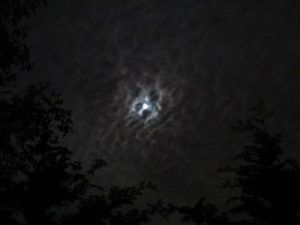
Nearly a Full Corn-Planting Moon during the week
— NIGHT SKY: On Saturday, the moon turned full, the Full Corn-Planting Moon. Look for a bright red Mars for weeks. (The photograph is of the almost-full moon over Monroe and Jamesburg.)
— VEGETABLE GARDENING: I got the vegetable garden in on Saturday, May 21, working in and out of rain. I am a bit concerned I went by the calendar, using May 20 as my guide to when the soil normally would be warm enough to plant, rather than by this year’s still-cool weather. That is, the soil may still be too cool for the warm-season vegetable plants. Perhaps I should have waited to June 1. No matter if I went with my heart over my head, the crop is in: Mammoth Gray-Stripe Sunflower, Cuppa Joe Sweet Corn, Rutgers Tomato, Hale’s Best Jumbo Cantaloupe, Born-to-be-Mild Hybrid Hot Pepper, Kaleidoscope Mix Carrot, Northern X-tra-Sweet Hybrid Sweet Corn, Igloo Lettuce, Carnival Mix Sweet Pepper, and Tasty Green Cucumber.
— OLD SEEDS: The Mammoth Gray-Stripe Sunflower, Cuppa Joe Sweet Corn, and Tasty Green Cucumber are 2015 seeds, which still should produce a crop.
— HOW I SEED: For what it is worth, I do not single-seed. Instead, I place a few to a bunch of seeds per hole.
— POLLINATION IN THE VEGETABLE GARDEN: I am trying something new in the garden, adding flowers to attract pollinators. So, I threw around seeds of Burpee’s Bee and Butterfly Garden and Monmouth Conservation Foundation’s Project Pollinator/Kids for Conservation.
— GARDENING ZONES: As the area transitions from the cooler Zone 6 to the warmer Zone 7, because of global warming, we will have a longer growing season. The gardening downside, more erratic weather. For example, many days of rain, followed by long periods of droughty weather. And, of course, the environmental downside is the global warming.
— RACCOONS AT THE BIRD-FEEDER: I enjoy watching the nightly visit of a raccoon or raccoons at the bird-feeder, sometime joined by a skunk below the feeder. I guess the raccoons and skunk like the sunflower hearts/kernels I use – and they have to eat, too, while entertaining me. But I got tired of the raccoon/s knocking down the feeder night after night. So, for now, I am bringing the feeder inside the garage at night and putting it back out in the morning.
— BIRDS: House finches were flying around the yard, fluttering to trees, bird-feeder, and clothesline, having trouble landing. They must have been fledglings, trying to figure it all out.
— WHIP-POOR-WILL CALLING: About 10:45 to 11 p.m. Wednesday night, May 18, a whip-poor-will called loudly, if only sporadically. This was once a common bird here in the local Pine Barrens – calling ad nauseam through the overnight. But this one was the first I have heard in an estimated 6 years. I got reports of whip-poor-will calls from around my Helmetta Road neighborhood, so I hoping for a return of the whip-poor-will.
— MOUNTAIN LAURELS AND SNAPPING TURTLES: Mountain laurel should begin blooming about now. So, remember this bit of Pine Barrens lore: “The snapping turtle lays its eggs, when the mountain laurel blooms.” Watch for snappers crossing roads – probably a female headed to high ground from a swamp to lay eggs or a female returning to a swamp after laying her eggs on high ground. If helping the turtle along, move it in the direction it is traveling. I MOVE A SNAPPER ONLY WITH A SHOVEL, because here is more Piney lore to think about, “Only the setting sun or lightning makes the snapping turtle let go.” If bitten, try running a wire down its nostril to make it let go. (Moving a snapper by lifting it by its tail could hurt it – and, also, it could bite the mover and not let go….)
(Garden observations are from my yard in the Helmetta Road area. Pine Barrens observations are from the Helmetta-Monroe area Pines.)
Joe Sapia, 59, is a vegetable gardener, who gardens the same backyard plot as did his Italian-American father, Joe Sr., and his Polish grandmother, Annie Poznanski Onda. Both are inspirations for his vegetable gardening. And he draws inspiration on the local Pine Barrens from his mother, Sophie Onda Sapia, who lived her whole life in the local Pines, and his grandmother.
Article and photos by Joe Mish

This female red phase screech owl with erect ear tufts and large eyes looks as ferocious as it sometimes sounds.
The calm starlit night, made blacker by the dark phase of the moon, was the perfect setting for a peaceful night’s sleep. The windows were wide open and the air scented with honeysuckle as the gentle sounds of the night played a sleepy time lullaby.
Deep sleep and dreams were well under way when a primal scream, just outside the window, vibrated the walls. Everyone sat up, hearts beating wildly, sleeping coonhounds unleashing unheard of sounds that must have been reserved in the event they ever treed the devil.
Before my heart beat slowed, I figured the sounds had to come from a screech owl perched on a tree limb six feet from the bedroom window. The unearthly screams were one selection of screech owl vocalizations that include rapid clicking of its beak and a gentle wavering call that, through association with spooky movies can easily raise the hairs on the back of your neck.
The volume of a screech owls’ motivated scream is inconsistent with its small size. The eastern screech owl is about 9 inches tall, weighs around 6 ounces with a 24 inch wingspan and easily fits through a three inch nest box hole.
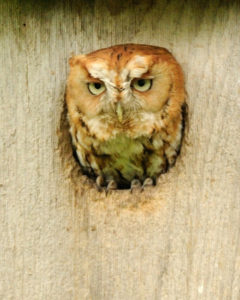
Adult red phase screech owl perches in 3″ hole of its nest box, note the feet gripping the edge of the opening.
Eastern screech owls come in two colors, a red phase and a gray phase. Its physical appearance, while perched, gives the impression it is missing the lower half of its body. During the day with its eyes shut it blends in so perfectly with its background it is difficult to tell what part is what. The owl seems to suddenly appear from the background when it opens its large yellow eyes.
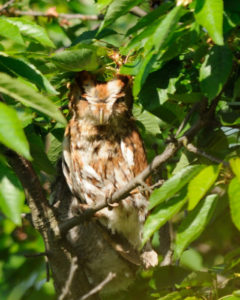
Eyes closed, these owls seems to disappear with no reference to top or bottom or recognizable form.
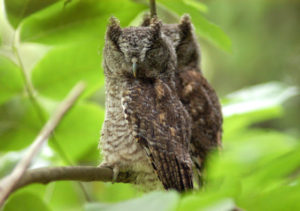
Screech owls seem to comfortably tolerate humans and can be seen, and will nest, in proximity to homes and buildings if a nest box is provided.
Late June early July, a screech owl would show up whenever I went into the backyard around dusk. It would follow me around and click its beak from a nearby branch. I have no idea what motivated that behavior but that owl provide plenty of photo opportunities.
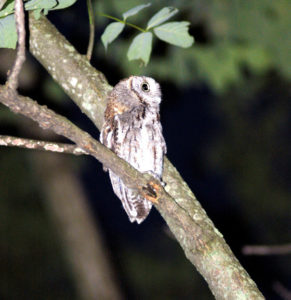
Then there were the memorable Christmas day visits. One Christmas morning I went to the open woodshed to replenish the woodstove with an armful of oak. There, staring me in the face from four feet away was a gray phase screech owl. It stayed put while I gathered the wood but was gone when I returned with my camera.
A few years later on Christmas night, a red phase screech owl perched a few feet off the ground in a weeping cherry tree. The little owl was spotted by the car’s headlights. It remained undisturbed while I did capture its image.
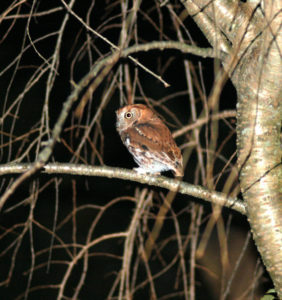
A late Christmas present in full feather, delivered at the front door.
Screech owls may just as well be found in deep woods. I have a great image of a red phase owl sitting in a healed hole in the side of a large tree trunk about eight feet off the ground. Other sightings have been in places where mature sycamore trees grow. Often, broken branches will leave a cavity that overtime becomes deeper, forming a perfect nest or day time resting place for this diminutive owl.
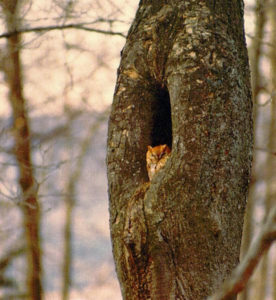
Though screech owls are quite common, you may never see one. Think of them as a night time radio host whose show you listen to all the time but never put a face to the voice. Hear a sampling of screech owl calls at: https://www.allaboutbirds.org/guide/Eastern_Screech-Owl/sounds
Author Joe Mish has been running wild in New Jersey since childhood when he found ways to escape his mother’s watchful eyes. He continues to trek the swamps, rivers and thickets seeking to share, with the residents and visitors, all of the state’s natural beauty hidden within full view. To read more of his writing and view more of his gorgeous photographs visit Winter Bear Rising, his wordpress blog. Joe’s series “Nature on the Raritan, Hidden in Plain View” runs monthly as part of the LRWP “Voices of the Watershed” series. Writing and photos used with permission from the author.






















